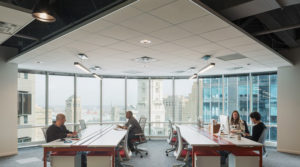The “sharing economy” is changing Philadelphia … and fast
As most of you already know, I was born/raised in the suburbs (Yo, Abington) until the age of 18 when I ventured off to college at La Salle University (Go Explorers). It wasn’t until I lived on/off campus at La Salle for 4 years that I realized how much I truly enjoyed living in the city, and my passion and pride for Philadelphia has grown every year since.
I’ve always been a big fan of history, architecture, and culture, and Philadelphia has copious amounts of all three, not to mention the food, the neighborhoods, the people, the events/festivals, and much more. Suffice to say, I moved to Philadelphia proper in 1997 and never looked back, which means I have now spent more than half of my life living in the city.
Fast forward to 2017, and Philadelphia is experiencing one of the biggest resurgences of urban life in the US. Our skyline is growing (Comcast Technology Center + FMC Tower, for starters), our population is rising (for the last 9 years straight, not to mention that we now have the 2nd largest downtown in the US), and our citizens are younger, educated, and more motivated than ever before (hello, millennial contingent). Just walk around Center City or University City any day/night of the week, and you’ll see what I’m talking about; the positive energy is contagious.
So, what does the sharing economy have to do with what I just said? Well, everything actually. As Philadelphia is growing and changing, so are the ways we work, live, and travel.
First and foremost, let’s define the “sharing economy” (I decided to take the simplest definition I could find, via Dictionary.com):
“A system in which people rent, borrow, or share commodities, services, and resources owned by individuals, usually with the aid of online technology, in an effort to save money, cut costs, and reduce waste.”
Now we can get technical here about what is considered the “sharing economy” (versus “on-demand services” or the “collaborative economy”), but if you know me well enough, you also know that I prefer to keep things simple. So let’s break this one down PUL.com-style:
- Office Space | How We Work: No, I’m not talking about the unbelievably-funny/accurately-portrayed movie by Mike Judge, I’m talking about Philadelphia’s commercial/office market and how it’s drastically changing … and fast. Take the office space that I work in for example, Pipeline Philly. It has all of the pros of a modern office space (enclosed offices, open work stations, floor-to-ceiling glass conference rooms, front desk/reception, etc), but in a more compact/yet-open atmosphere. I’m not sure of the exact amount of companies that work out of Pipeline today, but my guess is that’s it’s 50+. Yes, there are 2 floors of office space, approximately 20,000 sq ft, and 50+ different companies work there. That’s pretty amazing, especially knowing there are some floors in our building that only have 1 company. The collaborative work environment is alive and well in Philadelphia, as we are an emerging city for co-working spaces. Pipeline, WeWork, MakeOffices, Benjamin’s Desk, and Industrious round out some of the larger/more-popular spots, but there are many more smaller/niche spaces as well, such as Indy Hall, CultureWorks, CityCoHo, and Old City Collective. Shared office spaces and co-working are not only changing how our office buildings are designed, but it’s also reinventing the way we work.
- Residential Buildings | How We Live: This one may not be as much of a game changer, but it’s a direct reflection of Philadelphia’s changing office culture. Not only are today’s Philadelphians choosing downtown as their urban area of choice (Center City, University City, and surrounding neighborhoods), but their living preferences are driving the multifamily real estate market like never before. Out of all the residential-purposed cranes in Philadelphia’s sky today, only a few are constructing buildings that you can buy in (e.g. condominium buildings, such as One Riverside + 500 Walnut); which means all of the other residential-purposed cranes are constructing buildings that you can only rent in (i.e. apartment buildings, such as 1919 Market, Bridge, The Alexander (aka 1601 Vine), + The Ludlow at East Market). Reason being, today’s Philadelphian is not only waiting longer to buy his/her first home (ahem, millennials), but today’s Philadelphian is also downsizing from Suburban Philadelphia (ahem, empty-nesters). That is why apartments are a very hot commodity these days, as millennials and empty-nesters are Philadelphia’s largest population growth segments. Not only has Philadelphia’s apartment scene changed, but leasing flexibility is changing right alongside with it. AKA, Roost, + Airbnb also offer both residents and travelers living options like never before.
- Transportation | How We Travel: Philadelphia is known for having one of the best and most comprehensive bus/subway/commuter-rail systems in the US, but how Philadelphians prefer to get around is also changing fast. Services like Uber and Lyft have literally transformed Philadelphia’s transportation network overnight, while Philadelphia’s Indego bike-sharing service gives commuters another creative way to get around the US’ top city for bicycle commuting. I like to tell my clients, family, and friends that Philadelphia is a “manageable big city” (unlike our pals up in NYC), meaning that we are: compact, but not overcrowded; big, but not oversized; exciting, but not overwhelming. If you miss a train, hop in an Uber. If you miss a bus, grab a LyftLine or UberPool. Philadelphia now offers many different/convenient ways for people to get from A-to-B, at a reasonable cost, and in a short amount of time. Oh, and you can text and check email on your way!
So as you can see, the sharing economy is changing the way Philadelphians live, work, play, eat, and shop. If you would like to learn more about how the sharing economy is changing our city, check out this article from Sandy Smith at Philadelphia Magazine.
